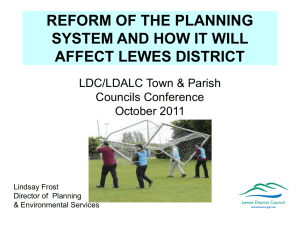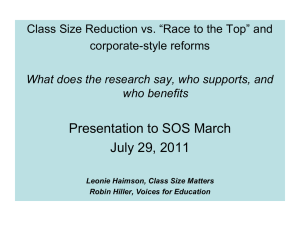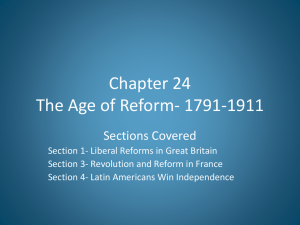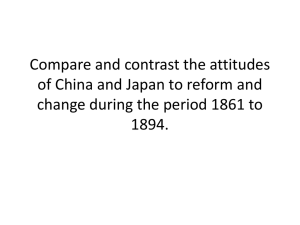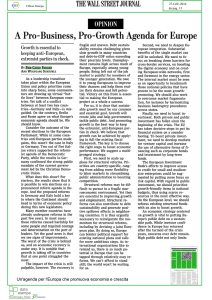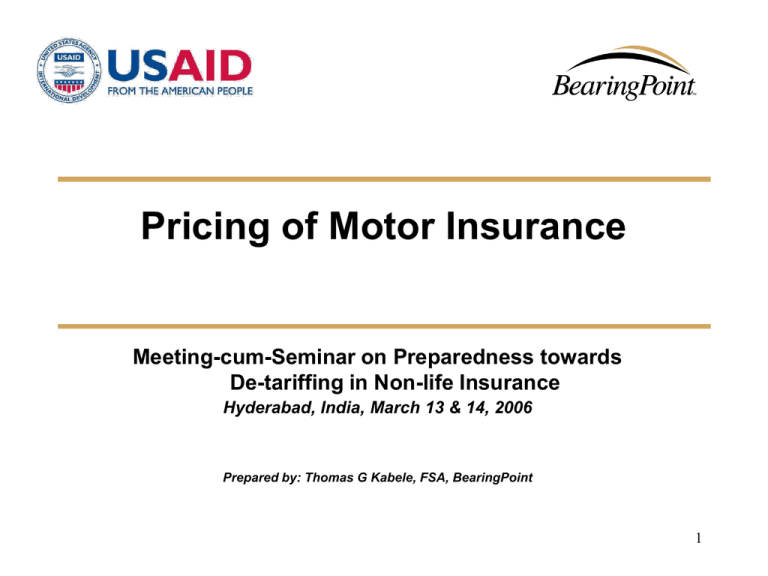
Pricing of Motor Insurance
Meeting-cum-Seminar on Preparedness towards
De-tariffing in Non-life Insurance
Hyderabad, India, March 13 & 14, 2006
Prepared by: Thomas G Kabele, FSA, BearingPoint
1
Forms of Motor Insurance
1. Trucks
2. Commercial Autos
3. Three Wheelers (motor rickshaws)
4. Private Auto
5. Two Wheelers (motor cycles)
Insurance Sector Reforms in India
Motor Rates in India
1. Now the rates are Subject to Tariffs
2. We will focus on Private Auto
3. Rates for “own damage” – vary by value of auto
4. Rates of “liability” – have “bonus malus”
Malus – higher rates for bad experience
Bonus – discounted rates for good experience
Insurance Sector Reforms in India
What will be Covered in this talk
1. India may be ahead of most places
2. U.S. Canada are good places to study
many jurisdictions, good data gathering, formal actuarial programs
case studies from NJ, MA, CA, BC
3. Likely effects of “risk rating”
examples of rate variation from New York
4. Pricing example from Bailey Simon
5. Rate Compression, Rate Depression
Insurance Sector Reforms in India
India may be ahead of most countries
1.
Many Eastern European countries still have tariffs.
2.
Many western European countries have no way of gathering data. No ISO,
No NCCI. No TAC.
3.
Most European Countries have no formal training program for casualty
actuaries.
4.
India has casualty actuarial study program based on UK (1-2 exams on
casualty). But UK exam material can be pricy.
5.
Indians can supplement UK, ASI material from US / Can Casualty
Actuarial Society study notes and journal articles including Astin Bulletin
are available for free.
Insurance Sector Reforms in India
Eventual Results from Detariff
Variations in liability rates
Driver demographics age, sex, marital status
1.
very high rates for unmarried young males (18-24)
slightly higher rates for unmarried young females (18-24)
slightly higher rates for unmarried males (25-29)
Area
2.
higher rates for crowed cities versus rural areas
rates vary by area. (New York State has about 100 areas)
rates higher for areas with more lawsuits
Mileage and use of car
3.
higher for commuters
lower for “pleasure use”
Insurance Sector Reforms in India
Rates based on Merit
Merit Rating
lower rates if accident and conviction free for 3 years
convictions include accidents that are “chargeable” and result in injury and
damage > certain amount
non chargeable accidents: damage to legally parked cars, or if hit in rear
Insurance Sector Reforms in India
Own Damage Rates, auto variables
that affect rates
1. Make, model of car
higher rates for cars that hard to repair
cars are rated by “crash worthiness”
higher rates to “muscle cars”
very high rates for very expensive cars: Astin Martin, Bentley, Ferrari,
Lamborghini, Masserati, Porsche, Rolls Royce.
2. Discounts for safety equipment, anti theft devices, anti lock
brakes
Insurance Sector Reforms in India
US and Canada
have many regulatory regimes
1.
US and Canada have many jurisdictions, different regulatory
systems but a similar product.
2.
US
Have 52 major jurisdictions (50 states, Puerto Rico, District of Columbia)
Policies are same or similar
Canada has 10 major jurisdictions
3.
Has 4 Atlantic provinces, Quebec, Ontario, Manitoba, Sask. Alberta, BC,
3 northern territories.
3 provinces have state owned auto cos. (BC, Sask. Manitoba)
Insurance Sector Reforms in India
US and Canada good places to study
1.
US and Canada have many regulatory regimes.
2.
US and Canada have good data gathering. In US NCCI
(National Compensation) and ISO (insurance Services Office)
and CLUE gather data.
3.
US and Canada have a good actuarial training programs
(Life Health Society of Actuaries)
(Property Casualty)
www.actuary.org (American Academy)
www.actuaries.ca
(Canadian Institute)
4.
UK, Australia, India also have training programs:
actuaries.org.uk; actuaries.asn.au, actuariesIndia.org.
5.
International actuarial association : actuaries.org
Insurance Sector Reforms in India
Example of Pricing
Canada Experience, Liability Insurance
1. Based on Bailey & Simon 1960, Casualty Actuarial Society
(casact.org)
2. Casualty Actuarial Society has many papers on automobile
pricing.
3. Other than U.S. and Canada few countries have an agency
to collect data.
4. India is advanced of many European countries and other
Asian Countries.
5. TAC may continue to collect data (like ISO, NCCI in U.S.)
Insurance Sector Reforms in India
Two Way Classification
1st: Driver / Use classification
Class
Driver / Use class
1
Pleasure, no male operator under 25
5
Married owner under 25
3
Business use (commuting)
2
Pleasure, non principal male operator under 25
4
Unmarried owner under 25
Insurance Sector Reforms in India
Two Way Classification
2nd: Merit Class
Merit Class
A
Licensed and accident free last 3 years
X
Licensed and accident free last 2 years
T
Licensed and accident free 1 year
B
All Other
Insurance Sector Reforms in India
Input: “Earned Car Years”
(number of cars in each class)
A
X
Y
B
Total
1
2,757,520
130,706
163,544
273,944
3,325,714
5
64,130
4,039
4,869
8,601
81,639
3
247,424
15,868
20,369
37,333
321,327
2
130,535
7,233
9,726
21,504
168,998
4
156,871
17,707
21,089
56,730
252,397
Total
3,356,480
175,553
219,597
398,445
4,150,073
Insurance Sector Reforms in India
Input: Losses Incurred $Can
A
X
Y
B
Total
1
63,191,000
4,055,000
5,552,000
11,809,000
84,607,000
5
1,752,000
114,000
178,000
382,000
2,426,000
3
9,589,000
701,000
1,011,000
2,383,000
13,684,000
2
4,598,000
380,00
439,000
1,088,000
6,505,000
4
7,964000
983,000
1,281,000
3,791,000
14,199,000
tot
87,094,00
6233,000
8,461,000
19,633,000
121,421,000
Insurance Sector Reforms in India
Loss Costs Per Car
29.26 = 121,421,000 / 4,150,073; 22.92 = 63,191,000 / 2,757,520
A
X
Y
B
Total
1
$22.92
31.02
33.95
43.11
25.44
5
27.32
28.22
36.56
44.41
29.72
3
38.76
44.18
49.63
63.27
42.59
2
35.22
52.54
45l14
50.60
38.49
4
50.77
55.51
60.74
70.00
56.26
tot
25.95
35.50
38.53
49.27
29.26
Insurance Sector Reforms in India
Loss Costs can be used as is
1. We have produced loss cost rates for each of the 20
combinations.
2. To compute premium we add expenses.
3. The premiums rates can be applied by the underwriter.
4. It is a good idea, however, to “smooth” the loss cost rates –
which is illustrated in the following slides.
Insurance Sector Reforms in India
Relativities = rates / 29.26
0.783 = 22.92 / 29.26; 0.934 = 27.32/29.26
A
X
Y
B
Total
1
0.783
1.060
1.160
1.473
0.870
5
0.934
0.965
1.250
1.518
1.016
3
1.325
1.510
1.696
2.162
1.456
2
1.204
1.796
1.543
1.729
1.316
4
1.735
1.897
2.076
2.392
1.923
tot
0.887
1.214
1.317
1.684
1.000
Insurance Sector Reforms in India
Smoothed Relativities
add col. total & row averages
1.084 = 0.214 + 0.870; 1.187 = 0.317 + 0.870
A
X
Y
B
ave
1
0.757
1.084
1.187
1.554
0.870
5
0.903
1.230
1.333
1.700
1.016
3
1.343
1.670
1.773
2.140
1.456
2
1.203
1.530
1.633
2.000
1.316
4
0.887
2.137
2.240
2.607
1.923
ave
0.887
1.214
1.317
1.684
1
-0.113
0.214
0.317
0.684
Insurance Sector Reforms in India
Smoothed Loss Costs per Car
Smoothed Rates = Smoothed Relativities * 29.26
22.15 = .757 * 29.26; 31.72 = 1.084 * 29.26
A
X
Y
B
Total
1
22.15
31.72
34.73
45.47
25.45
5
26.42
35.99
39.00
49.74
29.73
3
39.29
48.86
51.87
62.61
42.69
2
35.20
44.76
47.78
58.52
38.50
4
52.96
62.52
65.54
7627
56.26
tot
25.95
35.52
38.53
49.27
29.26
Insurance Sector Reforms in India
Other Models
1. We can also use a “least squares” approach to smooth the
data
ri, j b1 X1 b5 X 5 b3 X 3 b2 X 2 b4 X 4
c1YA c2YX c3YY c4YB
Insurance Sector Reforms in India
The variables are binary
1. Binary Variables
X 5 1 for class 5, 0 for other classes
YB 1 for merit class B, 0 for other merit classes
We have 9 variables to measure the 20 classes.
Insurance Sector Reforms in India
Bailey Simon discussion and Today’s Practices
1. 1960: data should be divided by territory
2. 1960: mileage is important
3. Today: One gets a discount for lower mileage.
4. Today: Sometimes there are Senior Citizen discounts for
lower mileage
Insurance Sector Reforms in India
Sample Auto Rates - NY
Rates vary by age, sex, marital class and territory
Manhattan
Queens
Brooklyn
Bronx
Urban
Buffalo
Suburbs
Clinton
County
F 20
1365
1487
2599
2911
595
489
1789
1909
3379
3949
713
597
F 69
769
851
1451
1563
313
249
M 35
943
1053
1801
1925
377
303
Unmarried
M 20
Unmarried
Insurance Sector Reforms in India
Discussion
1. Manhattan has good public transportation. Many people rent
cars when they drive. (Delhi is building a “metro”)
2. “Bronx Urban” is a poorer, crowded urban area
3. “Queens Urban” -- crowded urban area
4. Brooklyn (Kings Co.) crowed urban area
5. Clinton Co. rural area
Insurance Sector Reforms in India
More Discussion
1. Allstate and State Farm have separate companies for
substandard auto.
2. The assigned risk pool covers drivers at a reasonable rate.
3. The data is available on the New York State Insurance Dept.
web site.
www.ins.state.ny.us
click on “consumers” “auto” “consumers guide to auto insurance”
4. IRDA or TAC should consider a similar web site
Insurance Sector Reforms in India
Bronx Urban Rates
Assigned Risk
Allstate
Allstate
Geico
indemnity
Geico
Indemnity
M 20
3860
3949
4527
2669
3967
F 20
2513
2911
3558
1614
2550
M 35
2576
1926
2637
1205
1717
F 69
2529
1563
2832
1033
1717
Insurance Sector Reforms in India
Regulation of Auto Insurance
1. Indian currently has tariffs.
There is some variation by area
There is some surcharge for bad experience
There is a bonus system for good experience
2. Many European systems are similar
3. Some Euro. systems have high minimum rates – there are
few complaints by cos.
Insurance Sector Reforms in India
Tariffs are one form of regulation
Other forms
1. Prior approval
2. Modified prior approval
3. Flex rating
4. File & Use
5. Use & File
6. No File, maintain record
Insurance Sector Reforms in India
Typical rules
1. Personal lines are more regulated.
2. More “political” lines are more regulated.
auto
health
medical malpractice
3. Commercial lines often unregulated
Insurance Sector Reforms in India
Stringency of Regulation
1.
Klein, Phillips, Shiu, Journal of Financial Services, 2002 Capital Structure
of Firms Subject to Price Regulation, Evidence from Insurance Industry
2.
Developed 3 proxy measures for stringency of regulation.
3.
1: Size of residual market
4.
2. Conning External Climate index (1 to 5=most stringent). Uses
5.
type of rating law,
insurance department employees to number of firms
elected versus appointed commissioner
3. Regulatory disapprovals of NCCI (workers compensation) and ISO
(private auto insurance filing)
Insurance Sector Reforms in India
Two measures of “leverage”
1. 1, Ratio of liabilities to surplus – the traditional economic
measure
2. 2. ratio of net premium written to surplus – a measure often
used in the insurance industry.
Insurance Sector Reforms in India
Results of Klein, Phillips, Shiu
1. Companies reduce surplus in stringently regulated markets
2. Government intervention in market is desirable only when
severe market failures exist and government can ameliorate
the inefficiency caused by failures
3. But U.S. market is competitive
Insurance Sector Reforms in India
Rate Compression
Rate Depression
1. Rate Compression means the regulator will not let insurers
give full weight to experience factors – example must
charge young males less than experience rating.
2. Rate Depression means overall rates are inadequate.
3. Both lead to greater residual market and company
withdrawal
Insurance Sector Reforms in India
Stated Reasons for Rate Compression
1. Unfair to penalize high risk drivers (young males) who have
had no convictions.
2. Subsidizing bad drivers (those who have many convictions)
enhances public good by giving them insurance
Counter: driving insured means they cause even more accidents, and raise
rates even more.
Insurance Sector Reforms in India
Subsidies
and some possible ways of making them.
1. 1. Injured persons hurt by uninsured motorists
buy uninsured motorist protection
state subsidy, pay at pump?
2. 2. High risk drivers with no convictions
rate compression (MA, NJ, BC)
pay at pump – some discussion by economists
state owned auto insurer (BC, India)
charge each policy via assigned risk pool
3. 3. Bad drivers
same as (2), but less sympathy.
Insurance Sector Reforms in India
Pay at Pump
1.
Encourages conservation.
2.
Encourages clean burning hybrid and electric cars
3.
Mileage is important in accidents.
4.
Problems
5.
driver density is more important
rural drivers pay too much.
Doesn’t work to base whole premium on pay at pump, but might
be used to subsidize (1) those injured by uninsured motorists, (2)
high risks drivers (3) bad drivers.
Insurance Sector Reforms in India
Massachusetts
1. Massachusetts was regulated, then deregulated in 1977, but
rates went up. AEI Brookings Ch 2.
2. Mass. then reimposed regulation
3. Of 169 rating cells, 70% receive a subsidy while 74 paid a
surcharge. largest subsidy was $1951, 58.5% below cost.
Insurance Sector Reforms in India
Massachusetts
US 1998
MA 1998
Bodily Injury / 100 cars
1.17
2.29
Loss severity / claim
9,585
9,016
Injury Loss Cost / Auto
$112
$206
Property Damage/100 cars
4.09
7.06
Loss severity / claim
$2,010
$1785
Property Loss Cost / car
$82
$126
Insurance Sector Reforms in India
New Jersey
1. Brookings Chapter 3
2. New Jersey has higher or near highest rates in U.S.
1998 $1100 / car versus $400 Iowa
3. State is densely populated, 1134 people per square mile
(about 400 / sq km.)
4. Had 695.66 vehicles square mile
5. Residual market ran up $4 billion in losses
6. New Jersey suffered from fraudulent claims
Insurance Sector Reforms in India
New Jersey changes
1. Tried to reduce law suits
2. Introduced “basic” policy with lower limits – and no bodily
injury liability.
3. Has a “named driver exclusion” to reduce the rates of
parents with young males.
4. Has cross subsidies, an insured cannot be charged more
than 2.5 times the territorial rate.
Insurance Sector Reforms in India
California
1. Rates rose about 10% per year from 1978-1988.
2. Most drivers had no accidents
3. Proposition 103 in 1988
required regulated industry
abolished certain actuarial variables
—
use mile driven, years of experience, drivers record
had elected commission
rolled back existing rates
mandated safe driver discounts
Insurance Sector Reforms in India
California
1. AEI Brookings Chapter 5.
2. External factors limited losses after 1988
Circa 1988 Court case limited law suits
Enforced seat belt and Driving Under Influence of alcohol and Drug (DUI) laws
Roads improved.
Insurance Sector Reforms in India
California, Propositon103 1988
1. Rates based on 3 factors: driving record, miles driven,
years of driving experience
Area added later
2. Mandatory safe driver discounts
about 90% of those who meet years of experience requirement qualify.
3. Other changes
brokers could rebate commissions
Ins. Department provides shopping data base
Insurance Sector Reforms in India
Findings
1. No findings of “traditional” adverse consequences of
regulation:
exit of insurance companies
expanding assigned risk pool
declining industry profit.
2. Between 1989-98 US auto rates increased 33% while CA
auto rates decreased 10%
3. Counter arguments (Brookings p238, 244, 245)
insurers raised rates right before 1988 or didn’t decrease rates.
Residual market declined because rates were raised
Aggressive claim filing decrease after 1991 - measured by decline in ratio of
Bodily Injury to Property Damage Claims.
Rate decreases began in 1991
Insurance Sector Reforms in India
European Countries
1. AEI Brookings, Chapter 9.
2. UK not regulated auto insurance for many years.
3. European Union since 1994 trying to implement single
insurance market.
4. Belgium, Germany and France have bonus Malus system
(like India)
Insurance Sector Reforms in India
Canadian Experience
1. British Columbia has state owned auto insurance. Fraser
alert says
premiums are about 20% higher ($200)
accident rates are higher
rates are compressed – high risk drivers pay less than risk rating
Insurance Sector Reforms in India
Bibliography
1.
AEI Brookings, Deregulation Property Liability Insurance, Cummins ed.
2.
Journal Risk and Insurance (JRI, RMIR) papers on Japanese, Italian,
Austrian, Chinese auto markets
3.
Fraser Alert 2003 2004 discussion of government owned insurance co. in
British Columbia
4.
Klein, Philips Shi Journal of Financial Services
5.
NBER 1995 Suponcic and Tennyson, Rate Regulation and Auto
Insurance.
6.
Proceedings Casualty Actuarial (1960) Bailey & Simon
7.
American Academy of Actuaries (1990 Regulatory Filings for Health Plans
Insurance Sector Reforms in India





